Kyoto, Day Three
Or, Walking With A Laptop Is Difficult And Tiresome
I'll admit, I kind of screwed the pooch on this one. Shortly after I got back, I had to move to my new place (which is awesome, by the way), and then I managed to get slightly...distracted, shall we say.
In any case, here we go.
Primary target today was Nijo Castle, a relic of the Shogunate that controlled Japan prior to the Meiji revolution. This was the secondary bastion of the Shogun's power, a summer palace of sorts.
There's not much to see from outside, other than the moat and a corner guard tower, so let's just go inside, shall we?

This is the gate to Ninomaro palace, from which the Shogun ruled when he was present here.
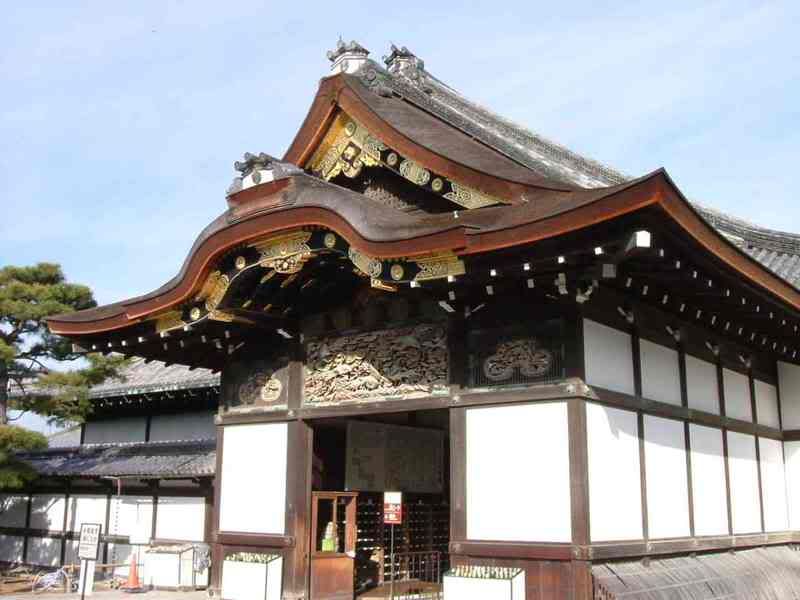
And here is Ninomaro itself, or at least the main entrance. It's a series of inter-connected buildings on a rough diagonal following the contour of a large pond in the garden, with rooms set aside for ministers and servitors as well as bodyguards, with the personal quarters of the Shogun at the far back of the room.
No pictures allowed inside, so I'll just fail to do it justice here.
The rooms are divided, as per the Japanese style, with mobile screens. Unlike most other places, these are not plain paper divisions, but lavishly decorated with paintings on what looks like gold leaf. The main guardroom has a leopard and cheetah motif -- or at least, exotic wild cats. Apparently the painters never got to see a real one, just pelts and descriptions, so it's to their credit or luck that they got it right. Another room for generals features some kind of monstrous pine tree, to represent strength or something along those lines.
The main audience chamber is likewise elaborately decorated, with gold and black enamel everywhere. It was apparently the site where the Emperor's power was restored following the Meiji revolution, and also a site of some importance after WW2, I think at the end of the American occupation? I'm not sure, I'll have to look that up.
At the back is the Shogun's personal quarters, where they had maquettes of the Shogun and his entourage of serving girls. One would serve tea to him, as presented to him by the Chief Housekeeper, a Madame of sorts, and if he drank the tea she would be made available for...services.
In any case, all the floorboards in the hallways are unique in that they are very squeaky. This is intentional, and known as the Nightingale Floor. Basically, it's a deterrent for would be covert assaults, because the floors would make so much noise that moving around undetected would be very difficult. Poor ninjas.
Here's the garden outside, still well maintained.
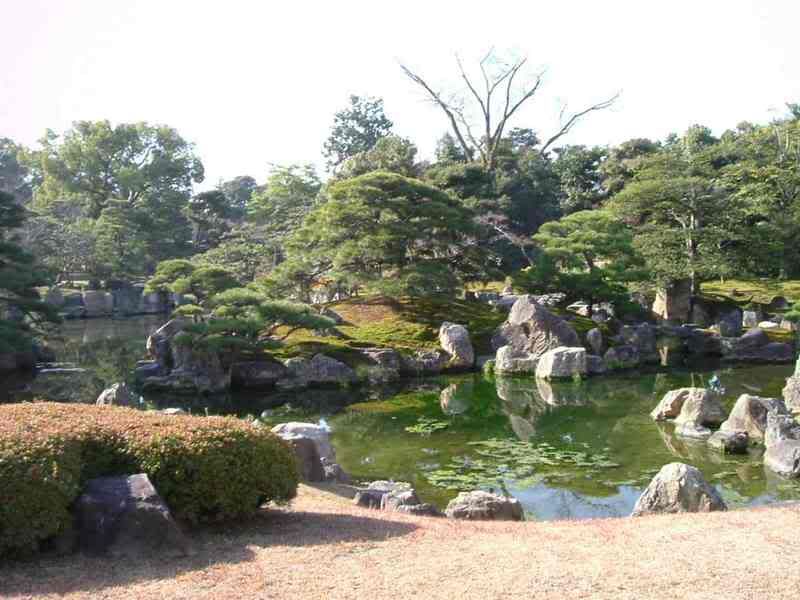
And the inner moat, complete with swans.

Now: you may notice that at the top of the walls, there are trees, and no battlements. There is a different construction philosophy here, compared to the Europeans. Presumably this is a combination of the Japanese sense of aesthetics and military philosophy. The walls are more massive earth-works help in place by the stones; the far side is a gentle slope of dirt that is landscaped into the gardens, and the trees and bushes at the wall-top provide pretty good cover for archers.

Clearly, assaulting the inner fortress, after having fought through the outer fortress, is probably a Bad Idea.
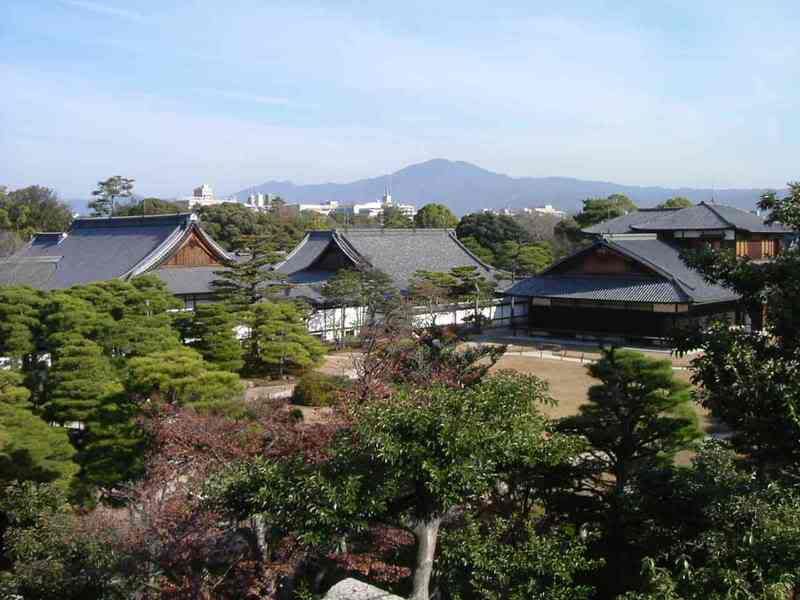
A view of the inner palace from the remains of the tallest guard tower. The second, inner palace area is actually off-limits, because it apparently houses an actual governmental function in the current system.
There are more pretty gardens scattered about inside, but this caught my attention:
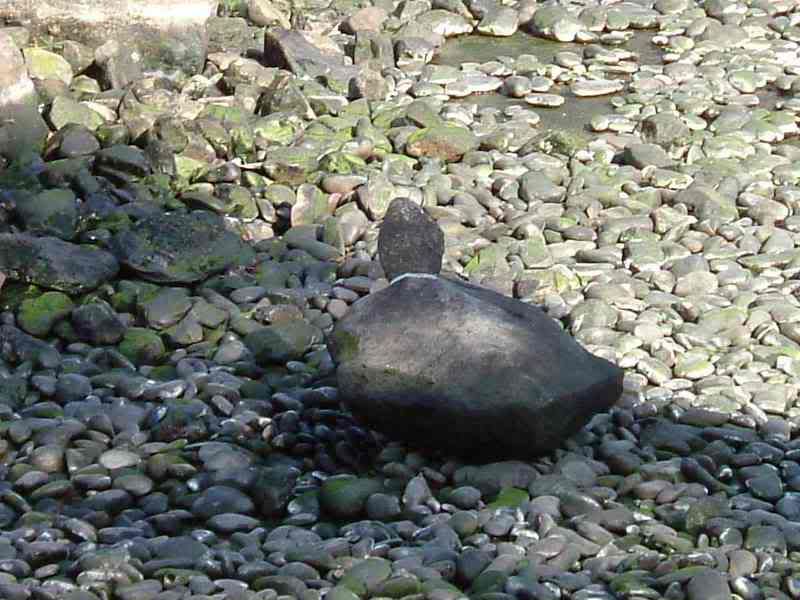
A rock turtle! I guess it looks even more turtle-like when the pond is full of water.
Anyway, moving on. My next target was Gingakuji temple, a Zen temple, but kind of far, so I got on the subway. Being a complete doof, after I got off the train I turned the wrong way and walked to the next stop instead of going the right direction.
So I ended up wandering through urban Kyoto for a while, which wasn't a terrible experience in and of itself. I've always wondered at the Japanese postal system, which relies on buildings numbered not in any linear order, but in order of construction. Based on the complete nuthouse of winding streets that make up Japanese residential areas, this actually makes a sort of sense. Put the same mailman on the same route everyday and it won't matter what order the houses are in, he'll find it.

Lunch: Curry Chicken
The Japanese take on curry chicken involves more breading and deep-frying. The sauce is not quite as spicy as I'm used to, but still satisfying. Weird asian coleslaw salad ahoy! Not terrible, though.
Here's a shot of Shimogamo shrine.
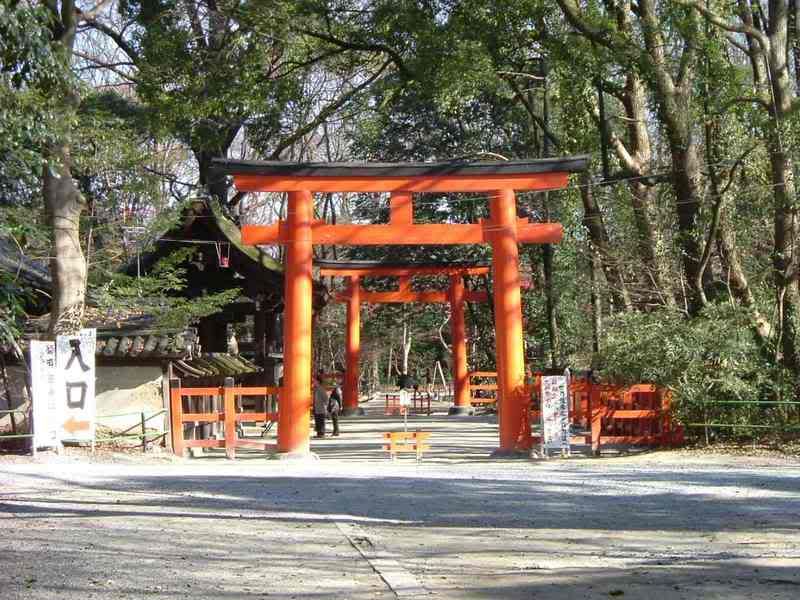
I didn't go in, because they were asking for more money and I'd seen enough shrines and had enough on the list already.
After lunch I continued wandering in the right direction, or so I assumed, anyway. Ginkakuji is located at the base of a hill with the kanji character for 'big' in it. ('Da', in Chinese, with the same meaning and shape, for those of you who know or care.)
So: Ginkakuji.
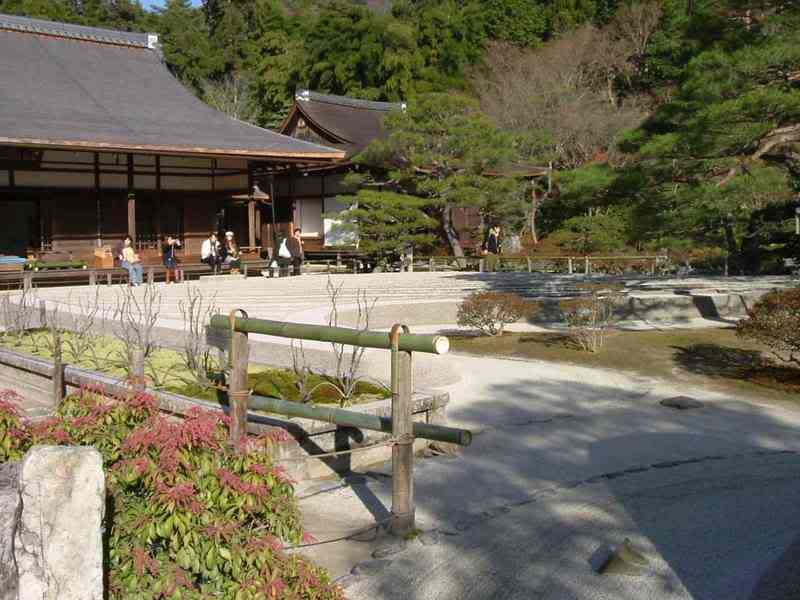
It's a pretty, quiet place, with mossy gardens and a lot of raked gravel. Apparetly the man who built it spend his entire life on it, and it rather shows.
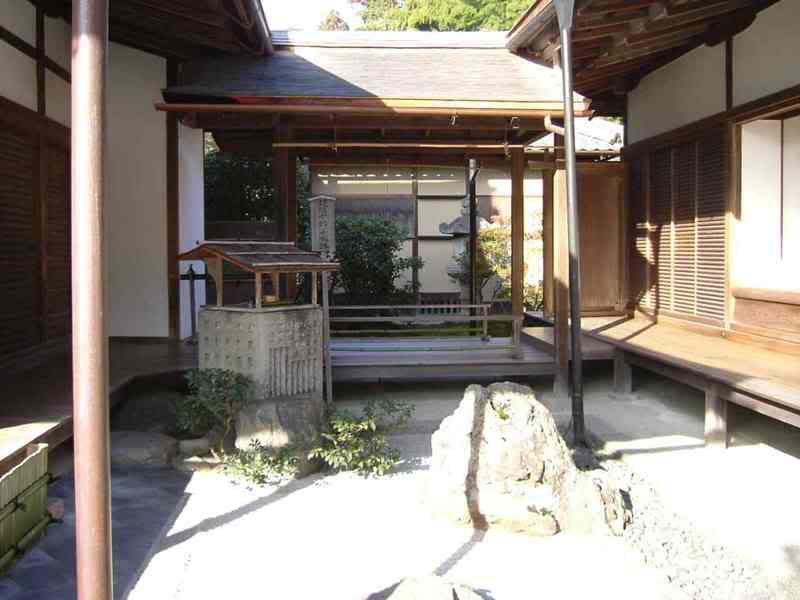
It's a very zen place.
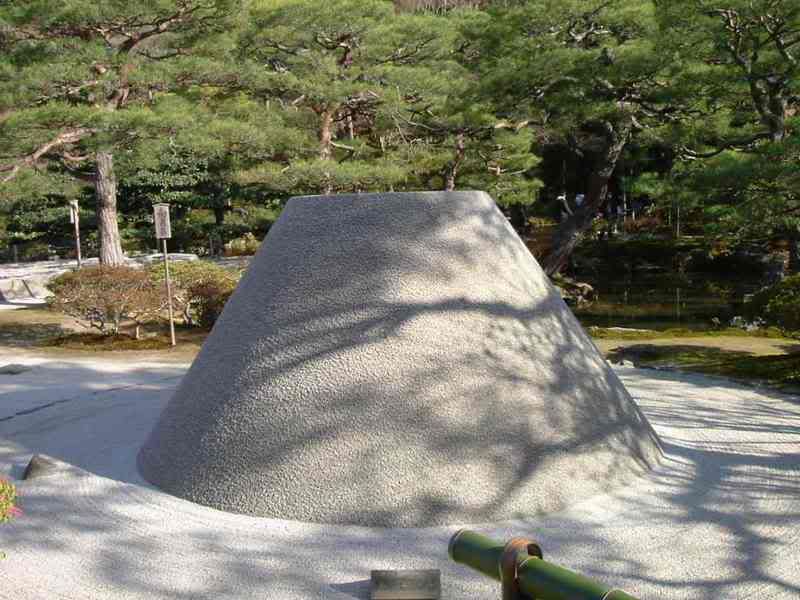
Here, a mound of gravel has been raked into a vague reminiscence of Mount Fuji.
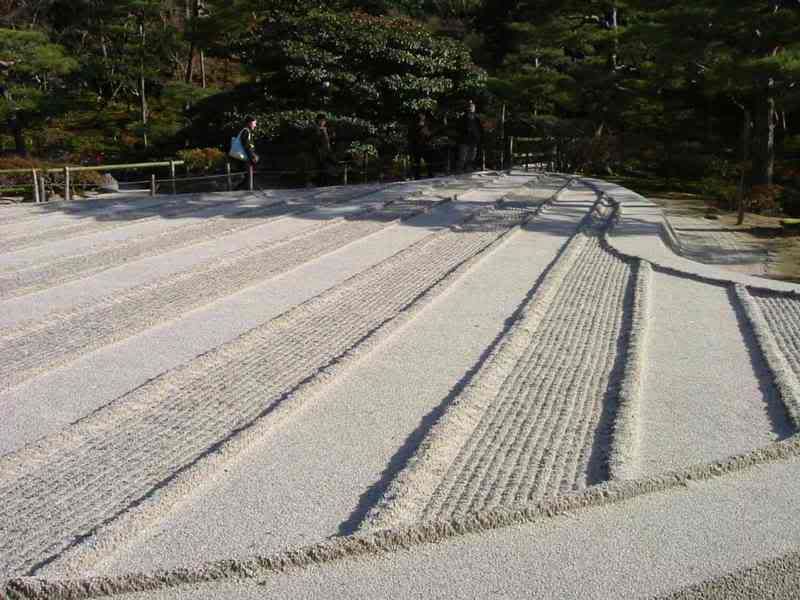
I won't pretend to understand this one.
Now, this was cool:
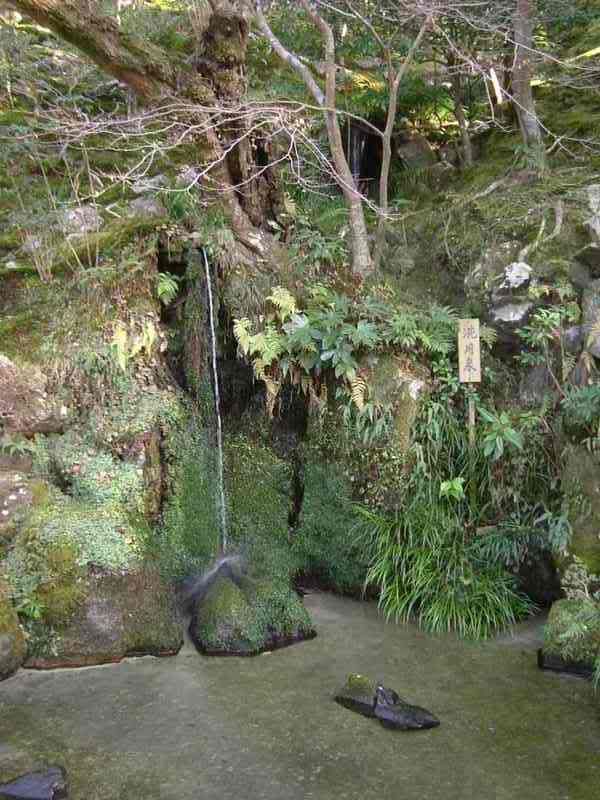
Whoever put this place together managed to prune and engineer the spring and the root of this tree such that the stream of water emerges at exactly the correct angle and momentum to strike the apex of the rock below it.
I was fascinated for about twenty minutes, but I doubt I achieved enlightenment in that period.
You can see pretty much all of the better part of Kyoto from here, too.
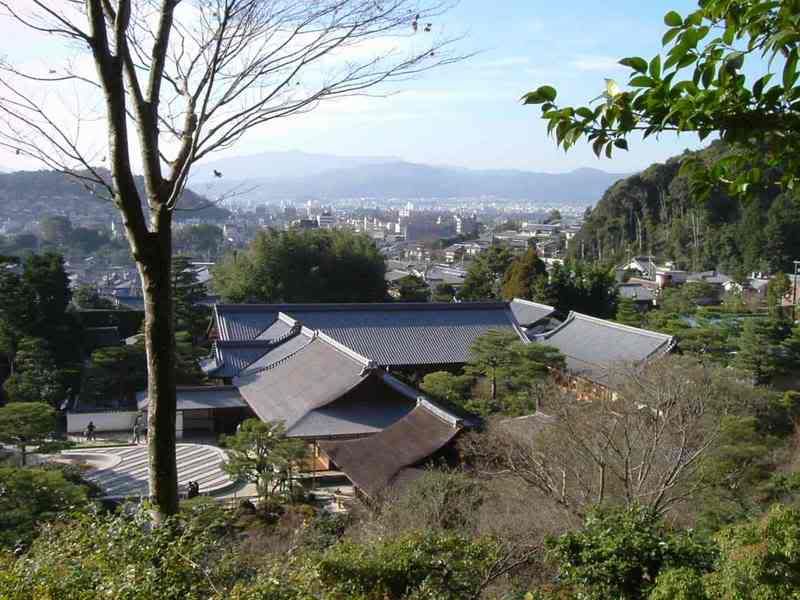
Upon returning to the hostel, I met my new room mates, a pair of Germans (one of whom was actually named Gunter, awesome). According to their Lost Planet guide, Gion was the neighbourhood to be in after dark, so we went there in the hopes of spotting some geishas.

Dinner: Okonomiyaki
Okonomiyaki is a local special, made from shredded cabbage and a bunch of tasty stuff all fried together into a patty remniscent of Swiss rösti. You can choose your toppings, it seems, and it's pretty damn tasty.
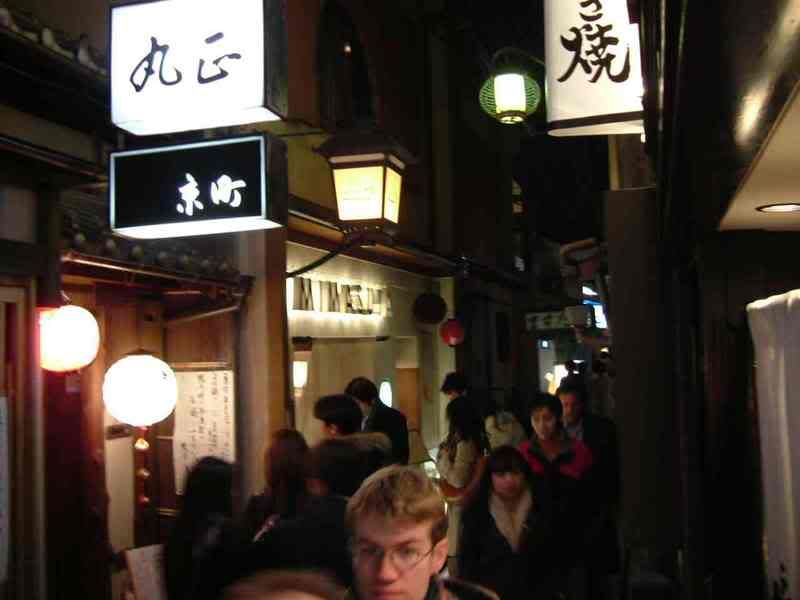
You can see Gunter there, right in the front, since I took this shot with the camera way over my head. It seems we came too early for the geishas, and the hostel's 10:30 curfew kind of ruined any chance of us actually seeing any.
But, we did manage to catch a pair of mikos in a restaurant, who I think are geishas in training. They looked mostly like geishas, and I think the distinction is quite subtle, so that was good enough for me.
End of day three.
I'll try to get more up more regularly.
I'll admit, I kind of screwed the pooch on this one. Shortly after I got back, I had to move to my new place (which is awesome, by the way), and then I managed to get slightly...distracted, shall we say.
In any case, here we go.
Primary target today was Nijo Castle, a relic of the Shogunate that controlled Japan prior to the Meiji revolution. This was the secondary bastion of the Shogun's power, a summer palace of sorts.
There's not much to see from outside, other than the moat and a corner guard tower, so let's just go inside, shall we?

This is the gate to Ninomaro palace, from which the Shogun ruled when he was present here.

And here is Ninomaro itself, or at least the main entrance. It's a series of inter-connected buildings on a rough diagonal following the contour of a large pond in the garden, with rooms set aside for ministers and servitors as well as bodyguards, with the personal quarters of the Shogun at the far back of the room.
No pictures allowed inside, so I'll just fail to do it justice here.
The rooms are divided, as per the Japanese style, with mobile screens. Unlike most other places, these are not plain paper divisions, but lavishly decorated with paintings on what looks like gold leaf. The main guardroom has a leopard and cheetah motif -- or at least, exotic wild cats. Apparently the painters never got to see a real one, just pelts and descriptions, so it's to their credit or luck that they got it right. Another room for generals features some kind of monstrous pine tree, to represent strength or something along those lines.
The main audience chamber is likewise elaborately decorated, with gold and black enamel everywhere. It was apparently the site where the Emperor's power was restored following the Meiji revolution, and also a site of some importance after WW2, I think at the end of the American occupation? I'm not sure, I'll have to look that up.
At the back is the Shogun's personal quarters, where they had maquettes of the Shogun and his entourage of serving girls. One would serve tea to him, as presented to him by the Chief Housekeeper, a Madame of sorts, and if he drank the tea she would be made available for...services.

In any case, all the floorboards in the hallways are unique in that they are very squeaky. This is intentional, and known as the Nightingale Floor. Basically, it's a deterrent for would be covert assaults, because the floors would make so much noise that moving around undetected would be very difficult. Poor ninjas.

Here's the garden outside, still well maintained.

And the inner moat, complete with swans.

Now: you may notice that at the top of the walls, there are trees, and no battlements. There is a different construction philosophy here, compared to the Europeans. Presumably this is a combination of the Japanese sense of aesthetics and military philosophy. The walls are more massive earth-works help in place by the stones; the far side is a gentle slope of dirt that is landscaped into the gardens, and the trees and bushes at the wall-top provide pretty good cover for archers.

Clearly, assaulting the inner fortress, after having fought through the outer fortress, is probably a Bad Idea.

A view of the inner palace from the remains of the tallest guard tower. The second, inner palace area is actually off-limits, because it apparently houses an actual governmental function in the current system.
There are more pretty gardens scattered about inside, but this caught my attention:

A rock turtle! I guess it looks even more turtle-like when the pond is full of water.
Anyway, moving on. My next target was Gingakuji temple, a Zen temple, but kind of far, so I got on the subway. Being a complete doof, after I got off the train I turned the wrong way and walked to the next stop instead of going the right direction.

So I ended up wandering through urban Kyoto for a while, which wasn't a terrible experience in and of itself. I've always wondered at the Japanese postal system, which relies on buildings numbered not in any linear order, but in order of construction. Based on the complete nuthouse of winding streets that make up Japanese residential areas, this actually makes a sort of sense. Put the same mailman on the same route everyday and it won't matter what order the houses are in, he'll find it.

Lunch: Curry Chicken
The Japanese take on curry chicken involves more breading and deep-frying. The sauce is not quite as spicy as I'm used to, but still satisfying. Weird asian coleslaw salad ahoy! Not terrible, though.
Here's a shot of Shimogamo shrine.

I didn't go in, because they were asking for more money and I'd seen enough shrines and had enough on the list already.
After lunch I continued wandering in the right direction, or so I assumed, anyway. Ginkakuji is located at the base of a hill with the kanji character for 'big' in it. ('Da', in Chinese, with the same meaning and shape, for those of you who know or care.)
So: Ginkakuji.

It's a pretty, quiet place, with mossy gardens and a lot of raked gravel. Apparetly the man who built it spend his entire life on it, and it rather shows.

It's a very zen place.

Here, a mound of gravel has been raked into a vague reminiscence of Mount Fuji.

I won't pretend to understand this one.
Now, this was cool:

Whoever put this place together managed to prune and engineer the spring and the root of this tree such that the stream of water emerges at exactly the correct angle and momentum to strike the apex of the rock below it.

I was fascinated for about twenty minutes, but I doubt I achieved enlightenment in that period.
You can see pretty much all of the better part of Kyoto from here, too.

Upon returning to the hostel, I met my new room mates, a pair of Germans (one of whom was actually named Gunter, awesome). According to their Lost Planet guide, Gion was the neighbourhood to be in after dark, so we went there in the hopes of spotting some geishas.

Dinner: Okonomiyaki
Okonomiyaki is a local special, made from shredded cabbage and a bunch of tasty stuff all fried together into a patty remniscent of Swiss rösti. You can choose your toppings, it seems, and it's pretty damn tasty.

You can see Gunter there, right in the front, since I took this shot with the camera way over my head. It seems we came too early for the geishas, and the hostel's 10:30 curfew kind of ruined any chance of us actually seeing any.
But, we did manage to catch a pair of mikos in a restaurant, who I think are geishas in training. They looked mostly like geishas, and I think the distinction is quite subtle, so that was good enough for me.
End of day three.
I'll try to get more up more regularly.